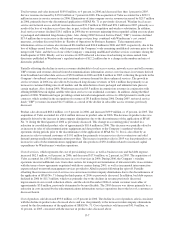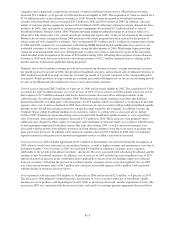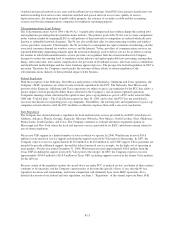Windstream 2006 Annual Report Download - page 116
Download and view the complete annual report
Please find page 116 of the 2006 Windstream annual report below. You can navigate through the pages in the report by either clicking on the pages listed below, or by using the keyword search tool below to find specific information within the annual report.
switched and special network access rates and broadband service offerings. State PSCs have primary jurisdiction over
matters including local service rates, intrastate switched and special network access rates, quality of service,
depreciation rates, the disposition of public utility property, the issuance of securities or debt and the accounting
systems used by telecommunications companies for regulatory reporting purposes.
Telecommunications Legal Reform
The Telecommunications Act of 1996 (“the 96 Act”) significantly changed and may further change the existing laws
and regulations governing the telecommunications industry. The primary goal of the 96 Act was to create competition
in the wireline market by requiring ILECs to sell portions of their networks to competitors at reduced wholesale rates
(known as unbundled network elements). The 96 Act also established rules for interconnecting wireline and wireless
service providers’ networks. Unfortunately, the 96 Act failed to contemplate the rapid evolution of technology and the
associated consumer demand for wireless services and the Internet. Today, providers of communications services are
regulated differently depending primarily upon the network technology used to deliver service. In an effort to reform
the manner in which telecommunications service providers are regulated, bills have been introduced in Congress
designed to reduce the existing level of regulation on the industry and update applicable laws governing, among other
things, interconnection, inter-carrier compensation, the provision of broadband services, universal service contribution
and distribution methodologies and the video franchise approval process. The prospect for federal legislation in 2007 is
uncertain. Therefore, the Company cannot predict the outcome of these efforts to reform regulation of the
telecommunications industry or their potential impact on the business.
Federal Regulation
With the exception of the Nebraska, New Mexico and portions of the Kentucky, Oklahoma and Texas operations, the
Company’s ILEC operations are subject to rate-of-return regulation by the FCC. The Nebraska, New Mexico and
portions of the Kentucky, Oklahoma and Texas operations are subject to price-cap regulation by the FCC that allows a
greater degree of retail pricing flexibility than is afforded to the Company’s rate-of-return regulated operations.
Companies meeting certain criteria had the option to elect price-cap regulation as part of a FCC order issued in May
2000 (the “CALLS plan”). The CALLS plan expired on June 30, 2005, and to date, the FCC has not established a
successor mechanism for regulating price-cap companies. Nonetheless, the existing rules and regulations for price-cap
companies remain effective until the FCC modifies or otherwise replaces them with a successor mechanism.
State Regulation
The Company has elected alternative regulation for local and intrastate services provided by its ILEC subsidiaries in
Alabama, Arkansas, Florida, Georgia, Kentucky, Missouri, Nebraska, New Mexico, North Carolina, Ohio, Oklahoma,
Pennsylvania, South Carolina, and Texas. The Company continues to evaluate alternative regulation options in
Mississippi and New York where the local and intrastate services provided by its ILEC subsidiaries remain subject to
rate-of-return regulation.
We receive USF support in a limited number of states in which we operate. In 2006, Windstream received $83.6
million in state universal service support excluding the support received by Valor prior to the merger. In 2007, the
Company expects to receive approximately $130.0 million to $140.0 million in state USF support. These payments are
intended to provide additional support, beyond the federal universal service receipts, for the high cost of operating in
rural markets. For the year ended December 31, 2006, Windstream received approximately $56.0 million from the
Texas USF excluding the support received by Valor prior to the merger. In 2007, the Company expects to receive
approximately $100.0 million to $110.0 million in Texas USF, including support received in the former Valor markets,
for the full year.
Because certain of the regulatory matters discussed above are under FCC or judicial review, resolution of these matters
continues to be uncertain, and the Company cannot predict at this time the specific effects, if any, that the 96 Act,
regulatory decisions and rulemakings, and future competition will ultimately have on its ILEC operations. For a
detailed discussion of our federal and state regulation, see Item 1. “Regulation” of this annual report on Form 10-K.
F-15
























